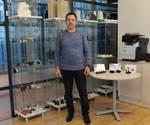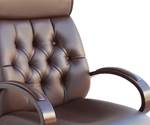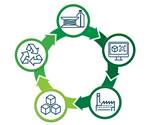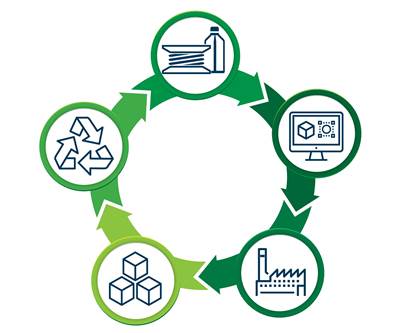The Case for Additive Manufacturing in Production
3D printing may have started out as a rapid prototyping technique, but the machines and materials have matured to the point that production is not only viable, but desirable, in many cases.

Additive manufacturing, the application of 3D printing technology for end-use parts, has arrived as a viable option for production, bringing advantages such as assembly consolidation, lightweighting, generative design and more. These topology optimized levers were made in an Additive Industries production additive manufacturing system.
Production additive manufacturing (AM) was once something to look forward to, a future application of 3D printing technology. Early adopters of 3D printing for rapid prototyping saw its value for design iteration and product development, but the material choices and systems were too limited to consider those early prints as final production parts. But times have changed. Where there was once just one type of 3D printing, there are now seven distinct families of processes and many, many machine suppliers. AM’s material portfolio is growing, adding new metal alloys, polymers and even composites all the time. Software is making the process more consistent and reliable, while also enabling next-generation designs that only additive can make. Production AM has officially arrived.
While the technology has advanced to production capability, a company’s decision to pursue production via AM is not an easy one. Would-be additive manufacturers must weigh factors beyond the manufacturing process itself. Production additive manufacturing requires equipment and systems beyond the printer itself, and the best use cases for additive manufacturing are found when the material, design, build, postprocessing and ultimate function of the part are all considered at once. But the benefits from this disruptive and interconnected approach can be far-reaching, from fewer fasteners and less assembly, to reduced inventory and shipping, to lighter weight, better performing parts and products.
Types of 3D Printing Technologies Used for Production
The first 3D printing technology was stereolithography, a technique that solidifies liquid resin into solid plastic parts by curing the material with projected light. Early materials for this process resulted in brittle prints that were useful as models and prototypes but unsuitable as end-use parts. Today there are many more printing technologies providing production-scale options in a growing range of material options.
For polymer part production, improved material selection makes stereolithography a viable option, as well as the similar Digital Light Processing (DLP) technique. Both processes cure liquid resin into a solid part, but the former does so point-by-point while the latter cures a full layer at once. But today’s plastic part producers also have other 3D printing options like material jetting, which precisely deposits droplets of polymer to build up a form; selective laser sintering (SLS) in which loose powder is melted together with a laser beam; and Multi Jet Fusion (MJF), a process developed by HP that uses a binding agent and UV light to fuse plastic powder. These technologies are attractive as production options as they allow for many identical or different parts to be printed at once on the same build plate or in the same build volume. Fused filament fabrication (FFF) or fused deposition modeling (FDM) printers can be applied to production applications as well; in this case, production volumes are typically reached by scaling the number of printers, rather than optimizing individual build plates.
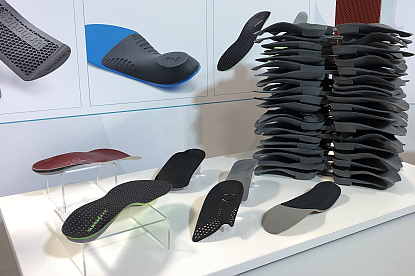
A benefit of powder bed-based systems is the ability to pack many parts into the same build chamber. The digital nature of 3D printing also makes it possible to make many different or custom parts at once, such as these insoles made on the HP Multi Jet Fusion platform.
Polymer 3D printing has a number of advantages for part production, chief among them the ability to manufacture plastic parts without procuring expensive, time-consuming and static injection mold tooling. The tooling-less and digital nature of the 3D printing process allows manufacturers to make parts in small quantities, to adjust designs and prototype alongside production, and even to produce variations on a single part or product with ease. Polymer 3D printing makes possible mass customization, a scenario in which the manufacturer tailors each individual product to the consumer. Post-print finishing is not always necessary for plastic parts, but many prints can tolerate bead blasting, dyeing, and other mechanical and chemical postprocessing to achieve the tolerances and aesthetics required by the application.

Fused filament fabrication (FFF) or fused deposition modeling (FDM) printers like these Markforged Mark 2 systems can be used in production as well, but often take the form of a “printer farm” or automated cell as seen here.
For metal part production, the most commonly used 3D printing technologies are powder bed fusion (PBF), binder jetting, and wire or powder deposition. These processes allow for the manufacture of complex designs not possible with machining or casting, as well as the use of materials that may not be well-suited to these other processes. Titanium, for instance, is difficult to machine but relatively easy to print via deposition or PBF. Most 3D printed metal parts will require some form of post-print machining, but are typically a faster route to a near-net shape than a standard casting or forging.
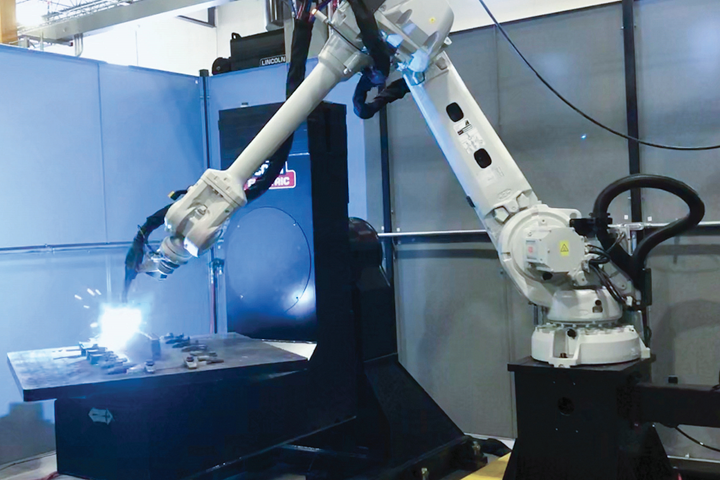
Directed energy deposition (DED) applies metal powder or wire to build up a part in a process similar to welding. Deposition heads are commonly mounted on gantries, machine tool spindles or robot arms as shown in this system developed by Lincoln Electric.
Deposition applies metal powder or wire to build up a part and can be combined with machining on the same platform for a hybrid manufacturing approach; it is often the process best suited to large parts such as propellent tanks and structural components. PBF works much like polymer SLS, using a laser or electron beam to sinter metal powder, while binder jetting applies a binder or “glue” to temporarily hold the metal powder together until it is sintered into a dense metal part. PBF and binder jetting are more commonly applied to small, complex components needed in higher quantities such as aerospace fuel injectors, medical implants and consolidated assemblies of automotive parts, for example. Similar to powder-based plastic processes, powder bed fusion and binder jetting allow for multiple parts to be grown at once within a build chamber, while deposition is more often applied to one or a small number of parts at a time.
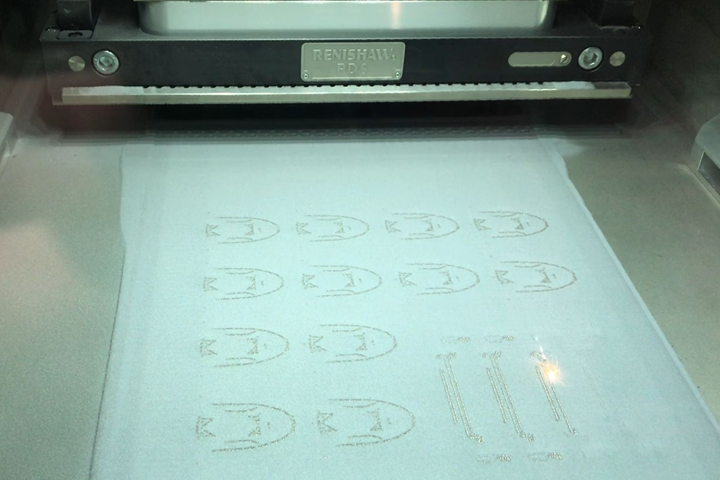
Powder bed fusion metal 3D printers utilize an electron or laser beam (shown here in this Renishaw printer used at Cobra Aero) to selectively melt metal powder and build up the part. The process is especially useful for small, complex items like medical implants.
When to Choose Additive Manufacturing
Additive manufacturing’s suitability for production does not mean that it will replace machining or injection molding or casting. It does mean, however, that manufacturers have an increasing variety of choices available. Recreating an existing casting, machined part or injection molded piece via 3D printing is unlikely to result in any real benefit for the manufacturer or user. However, redesigning an existing part or creating a new one with additive manufacturing in mind provides the opportunity to simplify manufacturing and provide better functionality. AM is the right choice when it provides benefits such as design improvements, material advantages, speed or cost savings.

This steering knuckle for the Fun Utility Vehicle (FUV), a next-generation electric car, illustrates the assembly consolidation and weight-saving benefits of additive manufacturing. The original design (right) is made up of multiple pieces welded together; redesigning this component for AM resulted in a lighter weight design that can be printed in just one piece (left; redesigned by ParaMatters, made in an EOS metal 3D printer and powder finished).
Whether working from an existing part or creating something new, manufacturers should focus on developing designs that take advantage of AM’s strengths. Software-driven design techniques such as generative design and topology optimization help to minimize weight and material usage, leading to lighter, more efficient parts and products manufacturable via 3D printing. Designing or redesigning for additive manufacturing often reveals areas of previously assembled parts that can be 3D printed as one piece, reducing the number of fasteners and the amount of labor needed to complete a product. 3D printing’s digital nature and lack of reliance on tooling also makes possible mass customization—a scenario in which each individual product can be tailored to the customer through its size, geometry, text or other characteristics.
The ability to alter the material properties of a part by changing its geometry can also help reduce the diversity of materials needed in any given component; altering the size and shape of a lattice cell geometry, for instance, can impart foam-like characteristics that vary in flexibility throughout the part. Additive manufacturing can also make it easier to manufacture in alternative materials. Machined aluminum parts, for example, may be more cheaply and easily 3D printed in plastic for the right application. The introduction of composite materials for 3D printing (generally plastics reinforced with chopped carbon fiber, glass, even graphene), is making this substitution even more attractive.

Conventional shoe insoles are made by layering multiple materials together that support the foot uniformly. In contrast, Aetrex can produce custom insoles like these using just two materials (a conventional sock liner and flexible 3D printed TPU); this “digital foam” approach (developed by EOS) varies the geometry of the lattices throughout the insole to provide different levels of support.
Without the need for tooling, 3D printing can be a more expedient and sometimes cheaper method for manufacturing compared to conventional processes such as injection molding and casting. Where it can take tens of thousands of dollars and weeks or months just to procure mold tooling, a plastic or metal 3D printing process makes it possible to obtain the part itself in a timespan of days or weeks.
All this being said, additive manufacturing does not necessarily need to be the only production method for a given part or product. It can be a useful means of “bridge production” to manufacture the initial run of a product while tooling is being secured, or to produce aftermarket and legacy parts after the main production run is over, freeing the OEM from continuing to make and store parts that may or may not be needed in the future.
Additive manufacturing is the right choice for production when the part or product can be improved by AM-enabled designs; when 3D printing can win on lead time or cost versus conventional processes; and/or when it enables custom or on-demand production as an alternative to standardized parts and goods held in inventory.
Potential Impact of AM for Production
Additive manufacturing is a disruptive technology and incorporating 3D printing into an existing business is no easy task. Companies will have to reconsider the designs of their products; how they think about production, shipping and inventory; perhaps even the kinds of materials that they use. Manufacturers looking to implement or grow the use of AM for production need to do so intentionally, with support from upper management, engineering, sales, and more.
But if a company is willing to embrace these changes, the payoffs can be significant and offer synergies with other goals. Sustainability is one example. Additive manufacturing enables the application of material only where it is needed, and supports the creation of the lightweight, efficient parts that will be key to next-generation electric vehicles and other “greener” products. The tooling-less nature of 3D printing also enables manufacturers to produce parts on demand, reducing inventory needs and ultimately wasted products and materials. AM can even be a means of giving new life to industrial scrap or post-consumer waste, which can be recycled into new pellets, filaments or powders for 3D printing.
The digital nature of the 3D printing process also makes it a viable production method for distributed, or decentralized, manufacturing. Without the need for hard tooling and large-scale warehouse capacity, it is no longer necessary to manufacture a given part in one central location. Instead, OEMs can divide production amongst several or many small 3D printing facilities that can be located near customers to make what is needed on demand. Production can shift quickly between machines and locations to any printer with the capabilities and material to make the part by simply sending the digital file where it is needed. Ultimately a digital and sustainable manufacturing model will support more flexible production and more secure supply chains — goals that additive manufacturing can help enable.
Learn more at AdditiveManufacturing.media and TheCoolPartsShow.com.
Related Content
3D Printing with Plastic Pellets – What You Need to Know
A few 3D printers today are capable of working directly with resin pellets for feedstock. That brings extreme flexibility in material options, but also requires greater knowledge of how to best process any given resin. Here’s how FGF machine maker JuggerBot 3D addresses both the printing technology and the process know-how.
Read More3D Printed Titanium Replaces Aluminum for Unmanned Aircraft Wing Splice: The Cool Parts Show #72
Rapid Plasma Deposition produces the near-net-shape preform for a newly designed wing splice for remotely piloted aircraft from General Atomics. The Cool Parts Show visits Norsk Titanium, where this part is made.
Read MoreHow Machining Makes AM Successful for Innovative 3D Manufacturing
Connections between metal 3D printing and CNC machining serve the Indiana manufacturer in many ways. One connection is customer conversations that resemble a machining job shop. Here is a look at a small company that has advanced quickly to become a thriving additive manufacturing part producer.
Read MoreHow Norsk Titanium Is Scaling Up AM Production — and Employment — in New York State
New opportunities for part production via the company’s forging-like additive process are coming from the aerospace industry as well as a different sector, the semiconductor industry.
Read MoreRead Next
How to Implement Additive Manufacturing Across a Global Company: 5 Lessons
With more than 100 facilities and about 200,000 employees worldwide, Flex has a steep challenge in bringing 3D printing into its operations. Five things the company is learning.
Read MoreWhat Your CEO Needs to Know About Additive Manufacturing
Additive manufacturing promises to affect far more than manufacturing alone. When evaluating AM, the perspective needed is the view that sees the impacts all across the enterprise.
Read MoreAdditive Manufacturing Will Aid And Accelerate The Circular Economy
A circular economy links material, design, manufacturing, product and end-of-life in a continuous, sustainable loop. This special report illustrates the roles for 3D printing every step of the way.
Read More
.jpg;width=70;height=70;mode=crop)
